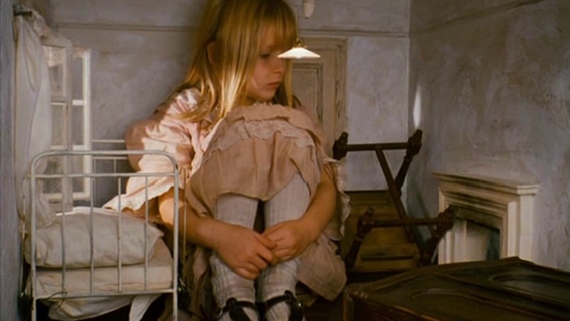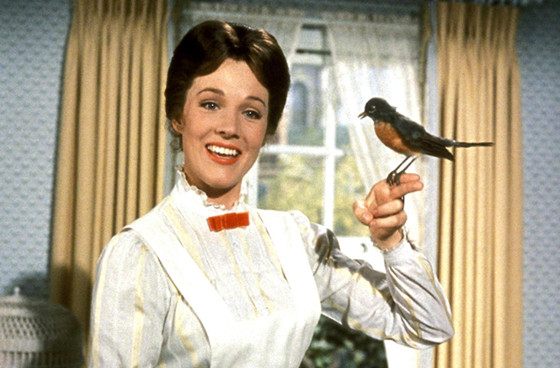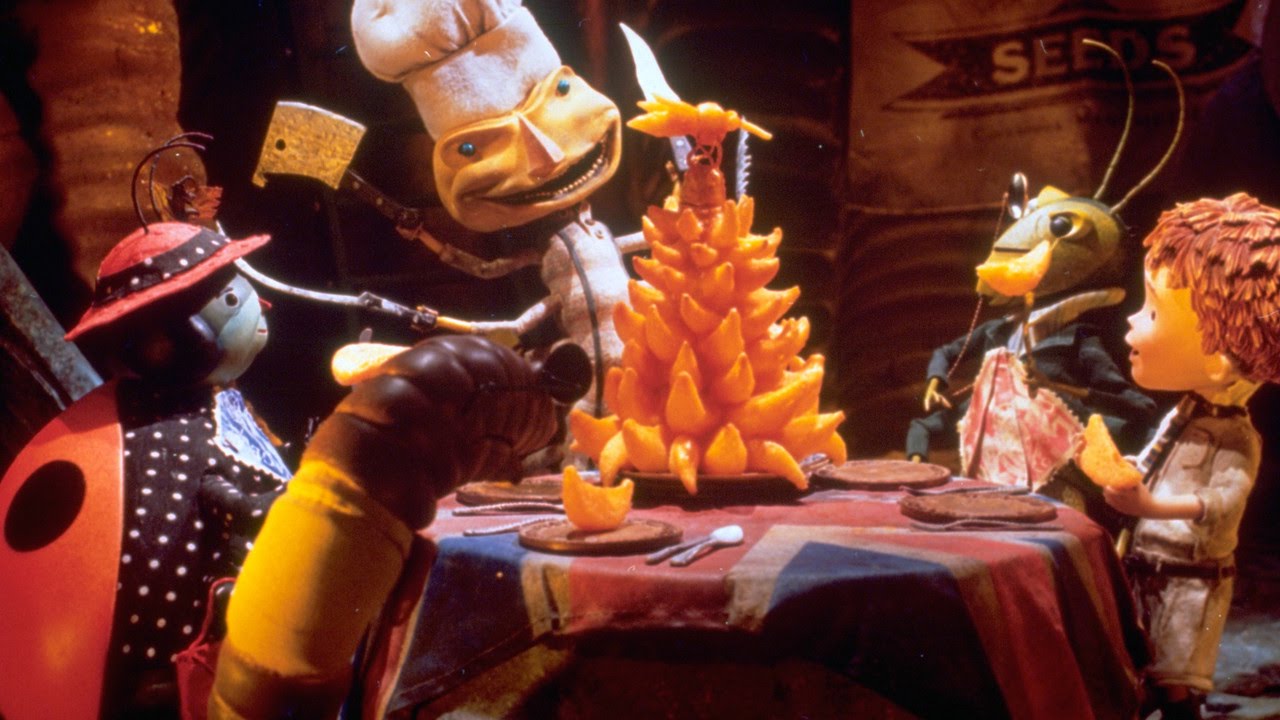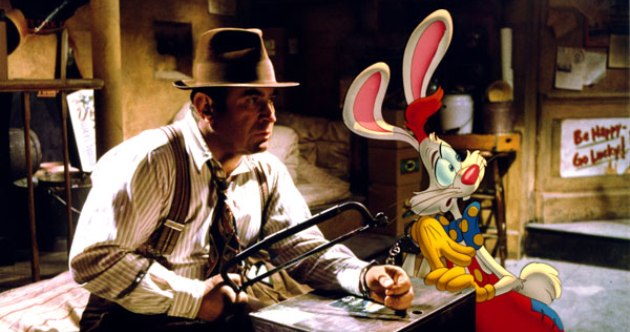5. Alice (Jan Svankmajer, 1988)

This surreal adaptation of Lewis Carroll’s classic novel is by far the most disturbing and bizarre of the tale’s many filmic interpretations. Using Czech director Jan Svankmajer’s famed style of stop-motion, the film tells the story of the young girl in the rabbit hole using a combination of live action acting, narration and animations with taxidermied animals and bones.
The film starts with Alice playing in her room when, all of a sudden, a menacing stuffed display rabbit, also in the room, pulls itself from its case and runs off, disappearing into a mysterious desk drawer. Alice follows curiously and disappears herself into the drawer. She finds herself falling down a long elevator shaft into the “wonderland” of the story. This new world, however, is not magical like in the novel, but instead a rundown apartment building in Czechoslovakia filled with rats and skeletal creatures.
Besides transforming the setting and style of the story, Svankmajer also cut Carroll’s story significantly, telling only a handful of events, adding some scenarios and drawing out many of the scenes, capturing atmosphere more than story. By cutting out major characters, such as the Cheshire Cat, Svankmajer may have decreased the flow of the story and the volume of absurdism.
This lack of whimsical fairy-tale nature, while changing the vibe, is replaced by the disturbingly crafted storytelling that Alice uses. The creepy interactions between the girl actress and stuffed animals retains none of the charm of the book, changing the film into a still magical, but much darker beast than most film versions. On the surface, many might say that this is a less true adaptation, however, given the dark backstory of Carroll’s life and the hidden connotations in the novel, it might well be the most fitting.
4. Mary Poppins (Robert Stevenson, 1964)

One of many literary adaptations on this list, this Disney classic takes it story and name from the book series by P.L. Travers. The film stars Julie Andrews in an Academy Award winning performance as Mary Poppins, a magical nanny who floats down from the sky to take of the Banks children, Jane and Michael, after their old nanny quits. She gets the job and proceeds to take the children on a series of fun and educational, magical adventures.
Along the way, they also meet Bert, a cockney street performer, played by Dick Van Dyke. Some of these events include magical carousels, flying kites and entering into fantastical chalk drawings. George Banks, the father of the household, is unsettled by the sudden happy change and speaks to Mary who convinces George to try and connect with his kids more. Although initially some trouble comes from this, in the end the family is happy together and the winds take Mary Poppins away again.
The animation in this film is less front-and-center than in most of the other films on this list, but it is just as important to the themes and plotline. The animations only appear when Mary Poppins uses some of her magic on the world, creating fantasy settings, or bringing animated creatures into real life.
These additions to the movie not only add to the magical atmosphere of the film but also keep it distinct in the viewer’s mind, leading to some of the most memorable scenes like when Bert dances with the animated penguins. Filled with forever hummable songs and iconic characters, Mary Poppins is a landmark Disney film and a staple of family entertainment.
3. James and the Giant Peach (Henry Selick, 1996)

Henry Selick, the director of stop motion classics like The Nightmare Before Christmas and Coraline, created this underrated classic based on the book by the Roald Dahl novel of the same name. The film starts out with live action film, although the environment is heavily stylized, following the young James Trotter whose parents are killed and then he is sent to live with his mean aunts.
Every day he s forced to toil all day for his aunts until he is given a magic bag of crocodile tongues by a mysterious man. James loses the tongues when they jump into the ground, but discovers that they have entered into a growing peach, transforming it into a giant peach. While the aunts try and turn the peach into a tourist attraction, James accidentally makes a whole in the peach and out curiosity, climbs inside.
Now is where the film transitions into the claymation that Selick is known for, as James discovers many giant insects living inside of the peach who he makes friends with. They cut away from the roots and take float into the Ocean, hoping to reach New York. along the way, however, they encounter many adventures, like the Arctic Cold and skeletal pirates. Like many of Roald Dahl’s stories, the content and style of the film can be a bit frightening or dark for some children.
Conversely, this also makes it more enjoyable for older people, increasing the accessibility of the film and the longevity of its legacy. With its wildly inventive imagery and great voice acting, James and the Giant Peach is a truly unique and memorable children’s fantasy film.
2. Pink Floyd – The Wall (Alan Parker, 1982)

Based on the seminal 1979 progressive rock album of the same name by Pink Floyd, Alan Parker’s psychedelic and disturbing portrait of rock star Floyd Pinkerton has grown to be one of the most iconic cult classics of all time.
The film follows Floyd’s upbringing and family history, including his father’s death during the war, showing his complex personality through disjointed episodes. His early life significantly influences Floyd’s character, never recovering from in school embarrassment and his overprotective mother.
As his life progresses, his reality slowly unwinds. More and more of his imagination takes control as he builds a metaphorical wall between himself and all those surrounding him, including his wife. The film climaxes in a surreal trial set in Floyd’s delusional mind, trying to tear down the wall around the man’s mind.
Devoid of much dialogue, the film consists of almost entirely the music from the band’s double album, composed by bassist Roger Waters, which, in fact, was originally written with a film in mind. Working with Waters and animator Gerald Scarfe, Parker created this devastating and disturbing internal picture of mental degradation.
The increasing presence of the animated figures throughout shows the similarly increasing distance that Floyd is from reality, providing both symbolic and stylistic content. Like the music of the album, the film is not for everybody, exploring many dark themes and progressing beyond the norm, but if you can get beyond the controversial nature of the film, the payoff is well worth it.
1. Who Framed Roger Rabbit? (Robert Zemeckis, 1988)

This hilarious send up of the noir-private eye genre stars Bob Hoskins as Eddie Valiant, a detective in a world that is inhabited by both people and cartoons. Ever since Eddie’s brother was killed in Toontown, however, he has since held a grudge against their kind and has turned to the drink. When R.K. Maroon, head of Maroon Cartoon Studios, notices that his main star Roger Rabbit, a cartoon, is acting strange, he hires Eddie to follow him and his wife, the sultry Jessica Rabbit.
Eddie uncovers that Jessica had been “playing patty-cake” on the side with Toontown owner Marvin Acme and tells Roger, making him freak out and run away. The next day Acme is found dead Roger is the main suspect. Eddie has to track down Roger and uncover what really happened before the ominous Judge Doom, played by Christopher Lloyd, can catch up to Roger and punish him himself.
While most of the central characters are original creations, many famous cartoons make cameo appearances as well, notably a hilarious piano duel between Disney’s Donald Duck and Daffy Duck of the Looney Toons. These clever references, intertwining with the classic noir characteristics, combined the thrilling plotline with goofy absurdism of the cartoon world, striking the perfect balance between comedy and mystery.
This family film, that is just as enjoyable for adults as it is for children, not only was a massive success, but it helped repopularize the animated genre, leading to the success of Disney films in the following decade.
Author Bio: Matthew Benbenek is an undergraduate Mechanical Engineering student at the University of Wisconsin – Madison. He has a passion for film, music and literature and, when not watching movies, is an amateur director and violin player.